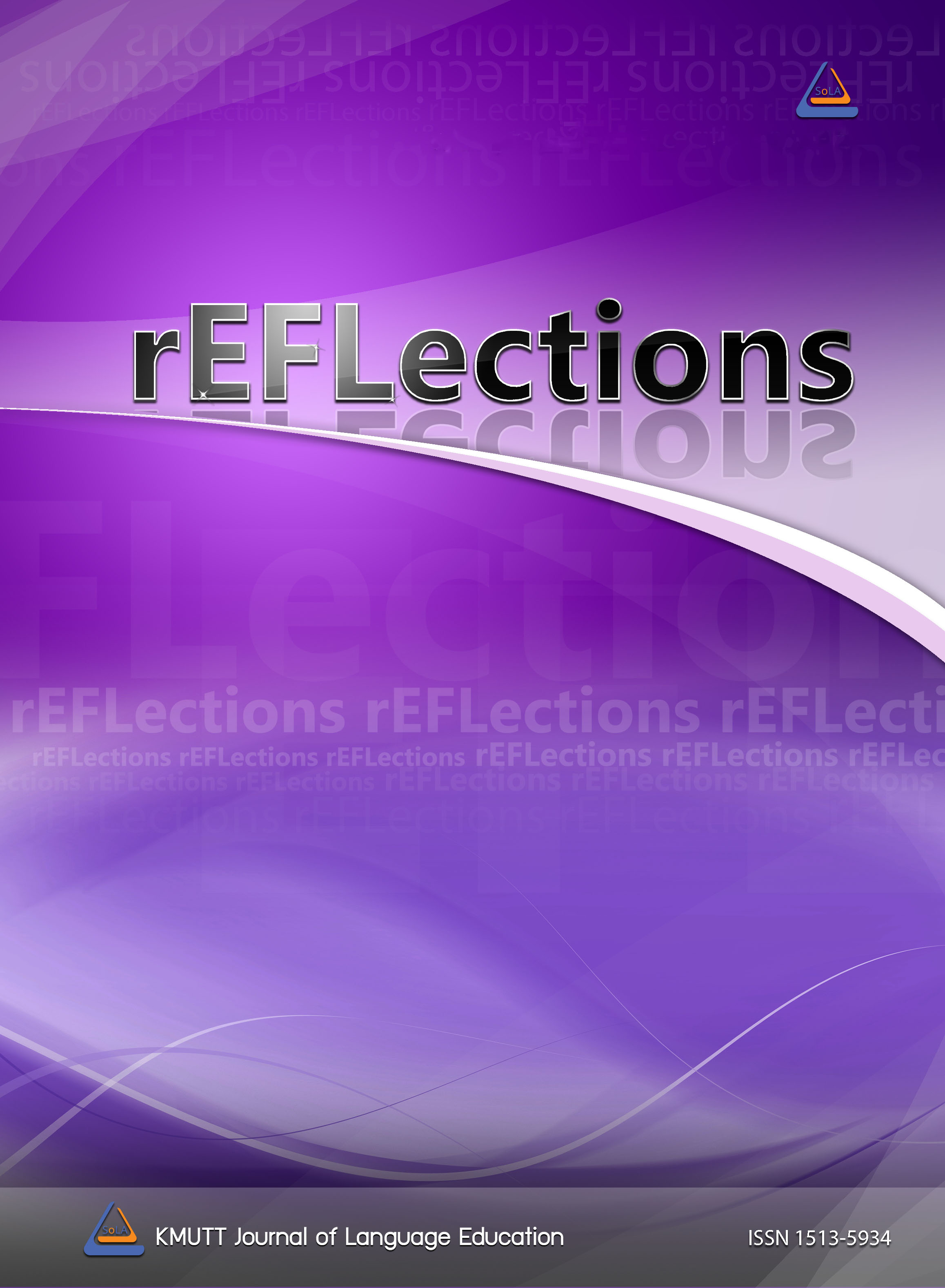Is Direct Speech the Norm in English-Thai Simultaneous Interpreting? The Effect of Gender-Specific Terms on the Use of Direct Speech in Interpreting
Main Article Content
Abstract
This study investigates using the concept of norms whether English-Thai interpreters regard direct speech as an appropriate interpreting style in simultaneous interpreting. It also explores whether gender-specific linguistic terms in Thai, which consist of first-person pronouns and formality-marking particles (FMPs), affect the interpreter to deviate from direct speech. Questionnaires and interviews were used to collect data. As a result, 12 interpreters answered the questionnaires, and four interpreters participated in the interviews. The results show that direct speech is the norm among the interpreters in this data set: 90.9% of respondents believed that English-Thai simultaneous interpreting should be done in the direct style, and 58.3% regularly used first-person pronouns and FMPs based on the speaker’s gender. However, some respondents did not use first-person pronouns or FMPs along these lines. Some of their reason might be to avoid gender-specific terms. The interviews’ results also showed that although the negative feelings toward using different-gender first-person pronouns and FMPs were different among individuals, all four interview participants admitted that they had misused FMPs when interpreting for the different-gender speakers. The results, therefore, suggest that gender-specific terms induce the interpreters to shift from direct to indirect speech.
Article Details

This work is licensed under a Creative Commons Attribution-NonCommercial-NoDerivatives 4.0 International License.
References
Angelelli, C. V. (2004). Revisiting the interpreter’s role: A study of conference, court, and medical interpreters in Canada, Mexico, and the United States. John Benjamins. https://doi.org/10.1075/btl.55
Angermeyer, P. S. (2009). Translation style and participant roles in court interpreting. Journal of Sociolinguistics, 13(1), 3–28. https://doi.org/10.1111/j.1467-9841.2008.00394.x
Attaviriyanupap, K. (2015). The linguistic representation of gender in Thai. In M. Hellinger & H. Motschenbacher (Eds.), Gender across language (Vol. 4, pp. 369–399). John Benjamins. https://doi.org/10.1075/impact.36
Bot, H. (2005). Dialogue interpreting as a specific case of reported speech. Interpreting, 7(2), 237–261. https://doi.org/10.1075/intp.7.2.06bot
Chesterman, A. (2016). Memes of translation: The spread of ideas in translation theory (Rev. ed.). John Benjamins. https://doi.org/10.1075/btl.123
Chesterman, A. (2017). Section IV: Norms. In A. Chesterman (Ed.), Reflections on translation theory: Selected papers 1993–2014 (pp. 165–191). John Benjamins. https://doi.org/10.1075/btl.132
Cheung, A. K. F. (2012). The use of reported speech by court interpreters in Hong Kong. Interpreting, 14(1), 73–91. https://doi.org/10.1075/intp.14.1.04che
Cheung, A. K. F. (2014). The use of reported speech and the perceived neutrality of court interpreters. Interpreting, 16(2), 191–208. https://doi.org/10.1075/intp.16.2.03che
Chodchoey, S. W. (1986). Strategies in Thai oral discourse [Doctoral dissertation, Pennsylvania State University]. ProQuest Dissertations and Theses Global.
Cooke, J. R. (1965). Pronominal reference in Thai, Burmese, and Vietnamese [Doctoral dissertation, University of California]. eScholarship. https://escholarship.org/content/qt9hf0g4gn/qt9hf0g4gn_noSplash_a09347fd32541e77810378fc5c410c81.pdf?t=nme1i7
Du Bois, J. W. (1986). Self-evidence and ritual speech. In W. L. Chafe & J. Nichols (Eds.), Evidentiality: The linguistic coding of epistemology (pp. 313–336). Ablex.
Duflou, V. (2012). The ‘first person norm’ in conference interpreting (CI): Some reflections on finding from the field. In M. A. Jiménez Ivars & M. J. Blasco Mayor (Eds.), Interpreting Brian Harris: Recent developments in translatology (pp. 145–160). Peter Lang. https://www.peterlang.com/document/1052320#documentdetails-anchor
Gile, D. (1999). Norms in research on conference interpreting: A response to Theo Hermans and Gideon Toury. In C. Schäffner (Ed.), Translation and norms (pp. 98–105). Multilingual Matters. (Reprinted from “Norms in research on conference interpreting: A response to Theo Hermans and Gideon Toury,” 1998, Current Issues in Language and Society, 5(1–2), 99–106, https://doi.org/10.1080/13520529809615506)
Harris, B. (1990). Norms in interpretation. Target, 2(1), 115–119.
Hoonchamlong, Y. (1992). Some observations on phǒm and dichǎn: Male and female 1st person pronouns in Thai. In C. Compton & J. F. Hartmann (Eds.), Papers on Tai languages, linguistics and literatures in honour of William J. Gedney on his 77th birthday (pp. 186–204). Northern Illinois University, Center for Southeast Asian Studies.
International Association of Conference Interpreter. (1999). Practical guide for professional conference interpreters. https://aiic.org/document/547/AIICWebzine_Apr2004_2_Practical_guide_for_professional_conference_interpreters_EN.pdf
Iwasaki, S., & Horie, P. I. (2000). Creating speech register in Thai conversation. Language in Society, 29(4), 519–554.
Iwasaki, S., & Ingkaphirom, P. (2005). A reference grammar of Thai. Cambridge University Press.
Merlini, R., & Favaron, R. (2009). Quality in healthcare interpreter training: Working with norms through recorded interaction. In S. Hale, U. Ozolins & L. Stern (Eds.), The critical link 5: Quality in interpreting – a shared responsibility (pp. 187–200). John Benjamins. https://doi.org/10.1075/btl.87.15mer
Ng, E. (2011). A survey of court interpreters’ use of direct versus reported speech in the Hong Kong Courts. International Journal of Law, Language & Discourse, 1(3), 29–58. https://www.ijlld.com/wp-content/uploads/2020/09/1-3-Ng.pdf
Ng, E. (2013). Who is speaking? Interpreting the voice of the speaker in court. In C. Schäffner, K. Kredens & Y. Fowler (Eds.), Interpreting in a changing landscape: Selected papers from critical link 6 (pp. 249–266). John Benjamins. https://doi.org/10.1075/btl.109.19ng
Pöchhacker, F. (2016). Introducting interpreting studies (2nd ed.). Routledge. https://doi.org/10.4324/9781315649573
Rosenberg, B. A. (2007). A data driven analysis of telephone interpreting. In C. Wadensjö, B. E. Dimitrova & A.-L. Nilsson (Eds.), The critical link 4: Professionalisation of interpreting in the community (pp. 65–76). John Benjamins. https://doi.org/10.1075/btl.70.09ros
Saisuwan, P. (2016). Kathoey and the linguistic construction of gender identity in Thailand. In E. Levon & R. B. Mendes (Eds.), Language, sexuality, and power: Studies in intersectional sociolinguistics (pp. 189–214). Oxford University Press. https://doi.org/10.1093/acprof:oso/9780190210366.003.0010
Saldanha, G., & O’Brien, S. (2013). Research methodologies in translation studies. Routledge. https://doi.org/10.4324/9781315760100
Sukgasi, B. (2018). Nihongo kara taigo eno houtei tsuuyaku niokeru ichininshou to bunmatsushi no shiyou ni kansuru kousatsu [A study of first person pronouns and final particles used in Japanese-to-Thai court interpreting] [Unpublished master’s thesis]. Rikkyo University.
Sukgasi, B. (2020). English-Thai interpreters’ use of direct style interpreting: The effect of gender-specific pronouns and formality-marking particles in Thai. Intercultural Communication Review, 18, 61–77. https://doi.org/10.14992/00019160
Toury, G. (2012). Descriptive translation studies – and beyond (Rev. ed.). John Benjamins. https://doi.org/10.1075/btl.100
Uehara, M. (2008). Tai no daigakuin niokeru tsuuyaku honyaku kyouiku no genjyou to doukou [Interpreting and translation education of the graduate schools in Thailand]. Tsuuyaku honyaku kenkyuu, 8, 337–354. https://doi.org/10.50837/its


